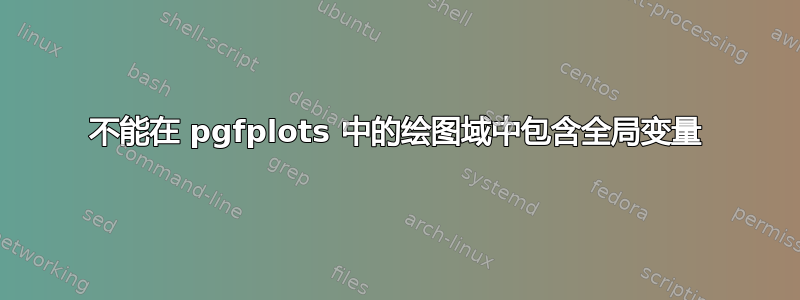
考虑将以下一段代码包含在包\begin{axis} ... \end{axis}中pgfplots:
\newcommand{\lineasVolumen}[3]{%
% #1,2 Volumen inicial, volumen final, #3 paso.
% Líneas de volumen constante:
\FPeval{\segundo}{(#1) + (#3)}
\pgfplotsforeachungrouped \volumen in {#1,\segundo,...,#2}{%
\addplot[white,samples=201,name path global=lineaVolumen,
domain=\minTs:\maxTs]
{621.98*(((\Pt)*(\volumen))/(287 *(x+273.159)) - 1)};
\path [name intersections={of=lineaSaturacion and lineaVolumen,
by=E}];
% Para dibujar las coordenadas x,y de la intersección:
\node[anchor=south, fill=white, fill opacity=0.75,text opacity=1] at (E) {
\pgfgetlastxy{\macrox}{\macroy}
\transformxdimension{\macrox}
\pgfmathprintnumber{\pgfmathresult},%
\transformydimension{\macroy}%
\pgfmathprintnumber{\pgfmathresult}
};
\node at (E) {
\pgfgetlastxy{\macrox}{\macroy}
\transformxdimension{\macrox}
\global\edef\coordX{\pgfmathresult}
};
\node at (E) {\coordX}; % HERE WORKS FINE.
\addplot[purple,samples=201,domain=\coordX:\maxTs] % HERE IT'S WRONG.
{621.98*(((\Pt)*(\volumen))/(287 *(x+273.159)) - 1)};
}
}
当我运行 pdflatex 时出现以下错误:
! 未定义控制序列。\pgfplots@plot@domain ->\coordX :\maxTs
l.259 \lineasVolumen{0.75}{0.95}{0.05}
我很沮丧,因为我尝试通过互联网寻找解决方案但没有成功。
我们需要保存交叉点的 x 坐标,然后在的域中使用\addplot。
我需要帮助!提前致谢!
这里是代码:
\documentclass{article}
\usepackage[a4paper,landscape,
left=1.5cm,right=1cm,
top=1.5cm,bottom=1.5cm,
headsep=0cm,footskip=0cm]
{geometry}
\usepackage{pxfonts} % palatino con símbolos matemáticos (incompatible amsmath)
\usepackage[spanish,es-nodecimaldot]{babel}
\renewcommand\shorthandsspanish{} % evita conflictos con tikz (ver spanish.pdf y
% notas.txt)
\spanishdecimal{,} %\decimalpoint
\usepackage{tikz}
\usepackage{pgfplots}
%\pgfplotsset{compat=1.5}
\usetikzlibrary{calc,intersections,through}
\usepgfplotslibrary{fillbetween}
\usepackage{fp}
\usepackage{xifthen}
\makeatletter
\newcommand\transformxdimension[1]{
\pgfmathparse{((#1/\pgfplots@x@veclength)+\pgfplots@data@scale@trafo@SHIFT@x)/10^\pgfplots@data@scale@trafo@EXPONENT@x}
}
\newcommand\transformydimension[1]{
\pgfmathparse{((#1/\pgfplots@y@veclength)+\pgfplots@data@scale@trafo@SHIFT@y)/10^\pgfplots@data@scale@trafo@EXPONENT@y}
}
\makeatother
% PARÁMETROS DEL DIAGRAMA ******************************************************
\newcommand{\ancho}{192mm}
\newcommand{\alto}{122mm}
\newcommand{\Pt}{101325} % en pascales (101325 a nivel del mar)
\newcommand{\minTs}{-10} \newcommand{\maxTs}{55}
\newcommand{\pasoTsPral}{5} \newcommand{\pasoTsSec}{1} % para rejilla de Ts
\newcommand{\minW}{0} \newcommand{\maxW}{33}
\newcommand{\Pvs}{exp((16.461*x-114.86)/(x+231.67))}
\newcommand{\lineasVolumen}[3]{%
% #1,2 Volumen inicial, volumen final, #3 paso.
% Líneas de volumen constante:
\FPeval{\segundo}{(#1) + (#3)}
\pgfplotsforeachungrouped \volumen in {#1,\segundo,...,#2}{%
\addplot[white,samples=201,name path global=lineaVolumen,domain=\minTs:\maxTs]
{621.98*(((\Pt)*(\volumen))/(287 *(x+273.159)) - 1)};
\path [name intersections={of=lineaSaturacion and lineaVolumen,by=E}];
% Para dibujar las coordenadas x,y de la intersección:
\node[anchor=south, fill=white, fill opacity=0.75,text opacity=1] at (E) {
\pgfgetlastxy{\macrox}{\macroy}
\transformxdimension{\macrox}
\pgfmathprintnumber{\pgfmathresult},%
\transformydimension{\macroy}%
\pgfmathprintnumber{\pgfmathresult}
};
\node at (E) { % sólo aquí funciona, pero \x sólo vale en otro entrecorchete
\pgfgetlastxy{\macrox}{\macroy}
\transformxdimension{\macrox}
\pgfmathsetmacro{\xx}{\pgfmathresult}
\global\edef\coordX{\xx}
};
\node at (E) {\coordX};
\addplot[purple,samples=201,domain=\coordX:\maxTs]
{621.98*(((\Pt)*(\volumen))/(287 *(x+273.159)) - 1)};
}
}
% ******************************************************************************
\pagestyle{empty}
\begin{document}
\vspace*{\fill}
\begin{center}
\begin{tikzpicture}
\begin{axis}[width=1.3*\ancho,height=1.3*\alto,
domain=\minTs:\maxTs,domain y=\minW:\maxW,
xmax=\maxTs,ymin=\minW,ymax=\maxW,
title={},
axis x line=bottom,xtick={\minTs,-\pasoTsPral,...,\maxTs},
axis y line=right,ytick={\minW,1,...,\maxW},yticklabel pos=right,
xlabel={},
ylabel={}]
% curva de saturación:
\addplot[blue,samples=201,name path global=lineaSaturacion]
{1000 / ((\Pt/1000)/(0.62198*1*\Pvs) -1.60777)};
%
\lineasVolumen{0.75}{0.95}{0.05}
\end{axis}
\end{tikzpicture}
\end{center}
\vspace*{\fill}
\end{document}
答案1
该解决方案使用\pgfplotsextra和\path代替。\draw\addplot
\documentclass{article}
\usepackage[a4paper,landscape,
left=1.5cm,right=1cm,
top=1.5cm,bottom=1.5cm,
headsep=0cm,footskip=0cm]
{geometry}
\usepackage{pxfonts} % palatino con símbolos matemáticos (incompatible amsmath)
\usepackage[spanish,es-nodecimaldot]{babel}
\renewcommand\shorthandsspanish{} % evita conflictos con tikz (ver spanish.pdf y
% notas.txt)
\spanishdecimal{,} %\decimalpoint
\usepackage{tikz}
\usepackage{pgfplots}
%\pgfplotsset{compat=1.5}
\usetikzlibrary{calc,intersections,through}
\usepgfplotslibrary{fillbetween}
\usepackage{fp}
\usepackage{xifthen}
\newcounter{id}
\makeatletter
\newcommand\transformxdimension[1]{
\pgfmathparse{((#1/\pgfplots@x@veclength)+\pgfplots@data@scale@trafo@SHIFT@x)/10^\pgfplots@data@scale@trafo@EXPONENT@x}
}
\newcommand\transformydimension[1]{
\pgfmathparse{((#1/\pgfplots@y@veclength)+\pgfplots@data@scale@trafo@SHIFT@y)/10^\pgfplots@data@scale@trafo@EXPONENT@y}
}
\makeatother
% PARÁMETROS DEL DIAGRAMA ******************************************************
\newcommand{\ancho}{192mm}
\newcommand{\alto}{122mm}
\newcommand{\Pt}{101325} % en pascales (101325 a nivel del mar)
\newcommand{\minTs}{-10} \newcommand{\maxTs}{55}
\newcommand{\pasoTsPral}{5} \newcommand{\pasoTsSec}{1} % para rejilla de Ts
\newcommand{\minW}{0} \newcommand{\maxW}{33}
\newcommand{\Pvs}{exp((16.461*x-114.86)/(x+231.67))}
\newcommand{\lineasVolumen}[3]{%
% #1,2 Volumen inicial, volumen final, #3 paso.
% Líneas de volumen constante:
\FPeval{\segundo}{(#1) + (#3)}
\foreach \volumen in {#1,\segundo,...,#2}{%
\path[samples=201,domain=\minTs:\maxTs,name path global=lineaVolumen]
plot (axis cs: \x, {621.98*(((\Pt)*(\volumen))/(287 *(\x+273.159)) - 1)});
\path [name intersections={of=lineaSaturacion and lineaVolumen,by=E}];
% Para dibujar las coordenadas x,y de la intersección:
\node[anchor=south, fill=white, fill opacity=0.75,text opacity=1] at (E) {
\pgfgetlastxy{\macrox}{\macroy}
\transformxdimension{\macrox}
\pgfmathprintnumber{\pgfmathresult},%
\transformydimension{\macroy}%
\pgfmathprintnumber{\pgfmathresult}
};
\node at (E) { % sólo aquí funciona, pero \x sólo vale en otro entrecorchete
\pgfgetlastxy{\macrox}{\macroy}
\transformxdimension{\macrox}
\pgfmathsetmacro{\xx}{\pgfmathresult}
\global\edef\coordX{\xx}
};
\node at (E) {\coordX};
\draw[red,samples=201,domain=\coordX:\maxTs,name path global=lineaVolumen]
plot (axis cs: \x, {621.98*(((\Pt)*(\volumen))/(287 *(\x+273.159)) - 1)});
};
}
% ******************************************************************************
\pagestyle{empty}
\begin{document}
\vspace*{\fill}
\begin{center}
\begin{tikzpicture}
\begin{axis}[width=1.3*\ancho,height=1.3*\alto,
domain=\minTs:\maxTs,domain y=\minW:\maxW,
xmin=\minTs,xmax=\maxTs,ymin=\minW,ymax=\maxW,
title={},
axis x line=bottom,xtick={\minTs,-\pasoTsPral,...,\maxTs},
axis y line=right,ytick={\minW,1,...,\maxW},yticklabel pos=right,
xlabel={},
ylabel={}]
% curva de saturación:
\addplot[blue,samples=201,name path global=lineaSaturacion]
{1000 / ((\Pt/1000)/(0.62198*1*\Pvs) -1.60777)};
%
\pgfplotsextra{\lineasVolumen{0.75}{0.95}{0.05}}
\end{axis}
\end{tikzpicture}
\end{center}
\vspace*{\fill}
\end{document}




